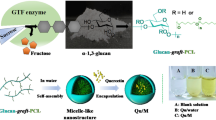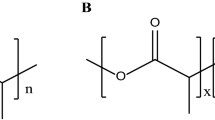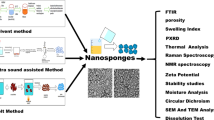Abstract
In current research work, pH responsive pectin-co-poly(MAA) hydrogels containing diloxanide furoate were developed by graft polymerization of pectin and methacrylic acid, for the treatment of amebiasis. Developed hydrogels were evaluated for drug loading efficiency, swelling behavior, porosity, sol–gel fraction and drug release kinetics. Ex vivo mucoadhesion, X-ray and acute oral toxicity studies were also conducted. Structural entanglement was revealed by FTIR spectroscopy. Differential scanning calorimetry (DSC) and thermogravimetric analysis (TGA) evaluation exhibited better thermal stability of developed hydrogel. The optimized hydrogel (PM6) showed pH responsiveness by providing maximum swelling of 95.16 ± 0.054% in alkaline media (pH 7.4), and 91.37 ± 0.53% drug release occurs in pH 7.4 up to 24 h. Scanning electron microscopy (SEM) revealed the presence of tiny channels in the network which significantly promote swelling of developed hydrogel. In vivo gastrointestinal transit behavior of optimized formulation (PM-6) was evaluated by X-ray imaging on albino rabbits. Acute oral toxicity studies after administered of developed hydrogel indicated no signs of histopathology or any dermal toxicity. Hence, current investigation suggests that PM6 could be a promising approach for colon delivery. Thus, the proposed work would be helpful for the treatment of amebiasis.
Graphical abstract





















Similar content being viewed by others
References
Jain SK, Jain A, Gupta Y, Ahirwar M (2007) Design and development of hydrogel beads for targeted drug delivery to the colon. AAPS Pharm Sci Tech 8(3):E34–E41
Jung J, Arnold RD, Wicker L (2013) Pectin and charge modified pectin hydrogel beads as a colon-targeted drug delivery carrier. Coll Surf B Biointerfaces 104:116–121
Ahmed EM (2015) Hydrogel: preparation, characterization, and applications: a review. J Adv Res 6(2):105–121
Bhattarai N, Gunn J, Zhang M (2010) Chitosan-based hydrogels for controlled, localized drug delivery. Adv Drug Deliv Rev 62(1):83–99
Park BG, Kang HS, Lee W, Kim JS, Son TI (2013) Reinforcement of pH-responsive γ-poly (glutamic acid)/chitosan hydrogel for orally administrable colon-targeted drug delivery. J Appl Polym Sci 127(1):832–836
Kulkarni RV, Boppana R, Mohan GK, Mutalik S, Kalyane NV (2012) pH-responsive interpenetrating network hydrogel beads of poly (acrylamide)-g-carrageenan and sodium alginate for intestinal targeted drug delivery: Synthesis, in vitro and in vivo evaluation. J Coll Interface Sci 367(1):509–517
Mishra R, Banthia A, Majeed A (2015) Pectin based formulations for biomedical applications: a review. Asian J Pharm Clin Res 4:1–7
Danish Z, Ijaz H, Razzaque G, Aslam MM (2021) Facile synthesis of three-dimensional porous hydrogel and its evaluation Polym Bull 1–22
Ijaz H, Tulain UR (2019) Development of interpenetrating polymeric network for controlled drug delivery and its evaluation. Int J Polym Mater Polym Biomater 68(18):1099–1107
Ijaz H, Tulain UR, Minhas MU, Mahmood A, Sarfraz RM, Erum A, Danish Z (2020) Design and in vitro evaluation of pH-sensitive crosslinked chitosan-grafted acrylic acid copolymer (CS-co-AA) for targeted drug delivery. Int J Polym Mater Polym Biomater 71(5):336–348
Azam F, Ijaz H, Qureshi J (2021) Functionalized crosslinked interpenetrating polymeric network for pH responsive colonic drug delivery. Int J Polym Mater Polym Biomater 70(9):646–655
Wolfe MS (1973) Nondysenteric intestinal amebiasis: treatment with diloxanide furoate. JAMA 224(12):1601–1604
García J, Ruiz-Durántez E, Valderruten NE (2017) Interpenetrating polymer networks hydrogels of chitosan and poly (2-hydroxyethyl methacrylate) for controlled release of quetiapine. React Funct Polym 117:52–59
Ganguly S, Maity PP, Mondal S, Das P, Bhawal P, Dhara S et al (2018) Polysaccharide and poly (methacrylic acid) based biodegradable elastomeric biocompatible semi-IPN hydrogel for controlled drug delivery. Mater Sci Eng C 2018(92):34–51
Bukhari SMH, Khan S, Rehanullah M, Ranjha NM (2015) Synthesis and characterization of chemically cross-linked acrylic acid/gelatin hydrogels: effect of pH and composition on swelling and drug release. Int J Polym Sci 2015:187961
Yin L, Fei L, Cui F, Tang C, Yin C (2007) Superporous hydrogels containing poly (acrylic acid-co-acrylamide)/O-carboxymethyl chitosan interpenetrating polymer networks. Biomaterials 28:1258–1266
Sutar PB, Mishra RK, Pal K, Banthia AK (2008) Development of pH sensitive polyacrylamide grafted pectin hydrogel for controlled drug delivery system. J Mater Sci Mater Med 19(6):2247–2253
Qu J, Zhao X, Ma PX, Guo B (2017) pH-responsive self-healing injectable hydrogel based on N-carboxyethyl chitosan for hepatocellular carcinoma therapy. Acta Biomater 58:168–180
Shah SA, Sohail M, Minhas MU, Khan S, Hussain Z, Mahmood A et al (2019) pH-responsive CAP-co-poly (methacrylic acid)-based hydrogel as an efficient platform for controlled gastrointestinal delivery: fabrication, characterization, in vitro and in vivo toxicity evaluation. Drug Deliv Transl Res 9(2):555–577
Huang J, Wigent RJ, Bentzley CM, Schwartz JB (2006) Nifedipine solid dispersion in microparticles of ammonio methacrylate copolymer and ethylcellulose binary blend for controlled drug delivery: effect of drug loading on release kinetics. Int J Pharm 319(1–2):44–54
Khan S, Ranjha NM (2014) Effect of degree of cross-linking on swelling and on drug release of low viscous chitosan/poly (vinyl alcohol) hydrogels. Polym Bull 71(8):2133–2158
Pham MN, van Vo T, Tran V-T, Tran PH-L, Tran TT-D (2017) Microemulsion-based mucoadhesive buccal wafers: wafer formation, in vitro release, and ex vivo evaluation. AAPS PharmSciTech 18(7):2727–2736
Déat-Lainé E, Hoffart V, Garrait G, Jarrige J-F, Cardot J-M, Subirade M et al (2013) Efficacy of mucoadhesive hydrogel microparticles of whey protein and alginate for oral insulin delivery. Pharm Res 30(3):721–734
Labelle M-A, Ispas-Szabo P, Masseau I, Chorfi Y, Mateescu M-A (2019) In vivo evaluation of targeted delivery of biological agents using barium sulfate. Int J Pharm 572:118801
Yassin AEB, Anwer MK, Mowafy HA, El-Bagory IM, Bayomi MA, Alsarra IA (2010) Optimization of 5-flurouracil solid-lipid nanoparticles: a preliminary study to treat colon cancer. Int J Med Sci 7(6):398
Abdullah O, Minhas MU, Ahmad M, Ahmad S, Ahmad A (2019) Synthesis of hydrogels for combinatorial delivery of 5-fluorouracil and leucovorin calcium in colon cancer: optimization, in vitro characterization and its toxicological evaluation. Polym Bull 76(6):3017–3037
Minhas MU, Ahmad M, Ali L, Sohail M (2013) Synthesis of chemically cross-linked polyvinyl alcohol-co-poly (methacrylic acid) hydrogels by copolymerization; a potential graft-polymeric carrier for oral delivery of 5-fluorouracil. DARU J Pharm Scic 21(1):1–9
Hosseinzadeh H (2010) Controlled release of diclofenac sodium from pH-responsive carrageenan-g-poly (acrylic acid) superabsorbent hydrogel. J Chem Sci 22(4):651–659
Ali L, Ahmad M, Aamir MN, Minhas MU, Shah HH, Shah MA (2020) Cross-linked pH-sensitive pectin and acrylic acid based hydrogels for controlled delivery of metformin. Pak J Pharm Sci 33(4):1483–1491
Abd El-Mohdy H, Hegazy E, El-Nesr E, El-Wahab M (2016) Synthesis, characterization and properties of radiation-induced Starch/(EG-co-MAA) hydrogels. Arab J Chem 9:S1627–S1635
Milosavljević NB, Milašinović NZ, Popović IG, Filipović JM, Kalagasidis Krušić MT (2011) Preparation and characterization of pH-sensitive hydrogels based on chitosan, itaconic acid and methacrylic acid. Polym Int 60(3):443–452
Kowalski G, Kijowska K, Witczak M, Kuterasiński Ł, Łukasiewicz M (2019) Synthesis and effect of structure on swelling properties of hydrogels based on high methylated pectin and acrylic polymers. Polym 11(1):114
Pourjavadi A, Barzegar S, Zeidabadi F (2007) Synthesis and properties of biodegradable hydrogels of κ-carrageenan grafted acrylic acid-co-2-acrylamido-2-methylpropanesulfonic acid as candidates for drug delivery systems. React Funct Polym 67(7):644–654
Wu J, Lin J, Li G, Wei C (2001) Influence of the COOH and COONa groups and crosslink density of poly (acrylic acid)/montmorillonite superabsorbent composite on water absorbency. Polym Int 50(9):1050–1053
Minhas MU, Ahmad M, Anwar J, Khan S (2018) Synthesis and characterization of biodegradable hydrogels for oral delivery of 5-fluorouracil targeted to colon: screening with preliminary in vivo studies. Adv Polym Technol 37(1):221–229
Chavda H, Patel C (2011) Effect of crosslinker concentration on characteristics of superporous hydrogel. Int J Pharm Investig 1(1):17
Tiwari V, Verma S, Verma SK, Dangi JS (2016) Enhancement of site specific delivery of diloxanide furoate as an antiamoebic drug. Eur J Pharm Sci 86:50–57
Chauhan GS, Kumari A, Sharma R (2007) Pectin and acrylamide based hydrogels for environment management technologies: synthesis, characterization, and metal ions sorption. J Appl Polym Sci 106(4):2158–2168
Pourjavadi A, Barzegar S (2009) Smart pectin-based superabsorbent hydrogel as a matrix for ibuprofen as an oral non-steroidal anti-inflammatory drug delivery. Starch Stärke 61(3–4):173–187
Huang S, Wang J, Shang Q (2017) Development and evaluation of a novel polymeric hydrogel of sucrose acrylate-co-polymethylacrylic acid for oral curcumin delivery. J Biomater Sci Polym Ed 28(2):194–206
Reddy BV, Rao GR (2008) Vibrational spectra and modified valence force field for N, N′-methylenebisacrylamide 46, 12–22
Giri TK, Thakur D, Alexander A, Badwaik H, Tripathy M, Tripathi DK (2013) Biodegradable IPN hydrogel beads of pectin and grafted alginate for controlled delivery of diclofenac sodium. J Mater Sci Mater Med 24(5):1179–1190
Piburn G, Barron A (2013) An introduction to energy dispersive X-ray spectroscopy Physical methods in chemistry and nano science 90–98
Mahmood A, Amara Sharif FM, Sarfraz RM, Abrar MA, Qaisar MN, Anwer N et al (2019) Development and in vitro evaluation of (β-cyclodextrin-g-methacrylic acid)/Na+-montmorillonite nanocomposite hydrogels for controlled delivery of lovastatin. Int J Nanomed 14:5397
Aslani P, Kennedy R (1996) Effect of gelation conditions and dissolution media on the release of paracetamol from alginate gel beads. J Microencapsul 13(5):601–614
Usman A, Pervaiz F, Shoukat H, Rehman S, Abid S (2022) Fabrication and characterization of novel semi-IPN hydrogels based on xanthan gum and polyvinyl pyrrolidone-co-poly (2-acrylamido-2-methyl propane sulfonic acid) for the controlled delivery of venlafaxine. Polym-Plast Technol Mater 61(6):577–592
Bigucci F, Luppi B, Monaco L, Cerchiara T, Zecchi V (2009) Pectin-based microspheres for colon-specific delivery of vancomycin. J Pharm Pharmacol 61(1):41–46
Minhas MU et al (2018) Synthesis and characterization of biodegradable hydrogels for oral delivery of 5-fluorouracil targeted to colon: screening with preliminary in vivo studies. Adv Poly Technol 37(1):221–229
Bashir S, Zafar N, Lebaz N, Mahmood A, Elaissari A (2020) Hydroxypropyl methylcellulose-based hydrogel copolymeric for controlled delivery of galantamine hydrobromide in Dementia. Processes 8(11):1350
Firyal MA, Hameed MA (2018) Controlled drug release of grafted pectin. J Drug Deliv Ther 8(5-s):215–222
Sadeghi M (2011) Pectin-based biodegradable hydrogels with potential biomedical applications as drug delivery systems. J Biomater Nanobiotechnol 2(1):36
Pandey M, Choudhury H, Segar Singh SK, Chetty Annan N, Bhattamisra SK, Gorain B, Mohd Amin MCI (2021) Budesonide-loaded pectin/polyacrylamide hydrogel for sustained delivery: fabrication, characterization and in vitro release kinetics. Molecules 26(9):2704
Author information
Authors and Affiliations
Corresponding author
Additional information
Publisher's Note
Springer Nature remains neutral with regard to jurisdictional claims in published maps and institutional affiliations.
Rights and permissions
Springer Nature or its licensor holds exclusive rights to this article under a publishing agreement with the author(s) or other rightsholder(s); author self-archiving of the accepted manuscript version of this article is solely governed by the terms of such publishing agreement and applicable law.
About this article
Cite this article
Mahmood, A., Mahmood, A., Sarfraz, R.M. et al. Hydrogel-based intelligent delivery system for controlled release of diloxanide furoate. Polym. Bull. 80, 8283–8319 (2023). https://doi.org/10.1007/s00289-022-04401-0
Received:
Revised:
Accepted:
Published:
Issue Date:
DOI: https://doi.org/10.1007/s00289-022-04401-0




